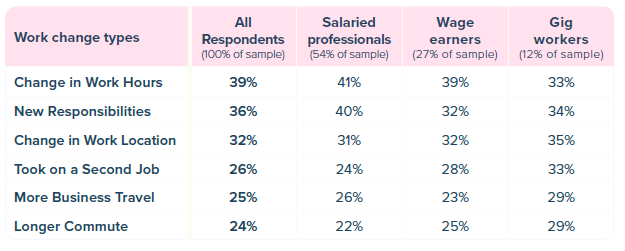It should come as no surprise that year after year, we continue to discover through new research just how expensive child care is for working families. With continuing economic uncertainty and a workforce still navigating work/life balance in a post-pandemic world, child care is more important than ever before. 3,000 U.S adults were surveyed for this year’s Cost of Care report, and while child care costs, availability, and accessibility differ for families around the country, there’s a resounding commonality: child care is unaffordable for the majority of families.
With the cost of care climbing to unprecedented heights in the last decade, the accompanying financial strain placed on households has caused working parents to make tough choices when it comes to work-life balance and their careers. According to those surveyed:
- 73% are currently working full time in the office
- 11% are working hybrid
- 8% remain working remotely
- 8% are working part time
As the unpleasant memory of the pandemic fades into the background of the last few years, more and more employees find themselves adjusting to changes at work that further escalate an increased need for support at home. 87% of working caregivers experienced at least one change in their work routine that caused an increase in childcare costs, placing additional strain on an already fatigued workforce struggling to locate, secure, and afford care for their loved ones. While a change in hours is the most commonly reported work change (39%), gig workers also are struggling with changes in work location that can dramatically impact the care options available for their families.
Work changes that caused an increase in child care costs

The business impact of caregiving benefits
In response to the rising costs and needs of care, employers are recognizing the strategic benefits of serving caregiver needs through employer-subsidized caregiving benefits, according to the 2023 Future of Benefits Report. In these fiscally constrained times, this recalibration may involve overall spending cuts. But increasingly, employers are calculating the risks of inadequate caregiver benefits and the rewards of upping their support. The economic impact of these challenges is undeniable:
- Reduction of women in the workforce: According to the McKinsey Global Institute, employers are potentially losing up to $840 billion in economic output due to diminished workforce participation of women—who tend to be the primary child caregivers.
- High attrition of working parents: Research suggests that in the past few years, nearly 20% of working parents had to leave work or reduce their work hours solely due to a lack of childcare. In a recent study, 26% of women who became unemployed during the pandemic said it was due to a lack of childcare.
- Lost productivity: $3 billion in revenue is lost annually due to employee absenteeism as the result of childcare breakdowns.
- Costly turnover: Turnover as a result of lack of childcare costs businesses 20% of an hourly employee’s salary and up to 150% of a manager’s salary.
Ultimately, 46% of companies in our study are deciding to do something about these risks and are prioritizing childcare more in 2023 (trailing only retirement plans as the most popular benefit to prioritize this year), and 43% are prioritizing senior care benefits. When asked about the impact of these offerings, a great majority of our respondents reported positive results in multiple strategic areas:
- Increased productivity (80%)
- Recruitment and retention of talent (78%)
- Workforce diversity (80%)
With this new data, it is easy to see that the cost of care has changed dramatically in the last 10 years, and no state or region across the country is immune as families continue to try to catch up. It is no wonder that for every data point discovered, families of all shapes, sizes, and backgrounds are struggling to afford child care and the profound impact this has on working parents and decisions regarding their careers. Now, more than ever, intervention is needed to empower these working parents with flexible benefit options that can support the care needs of their families at home.





